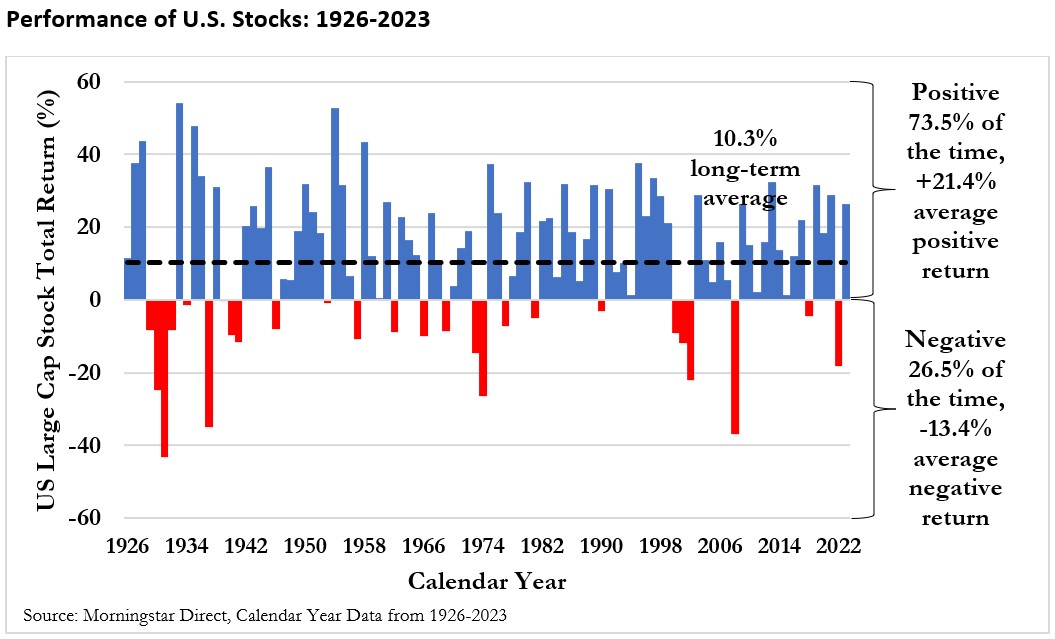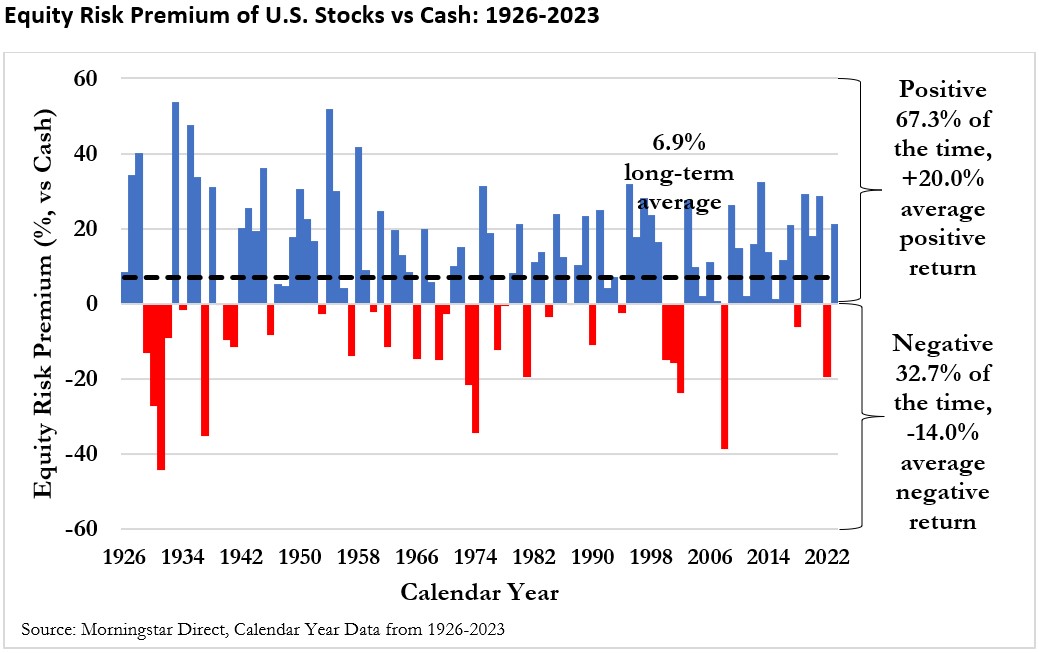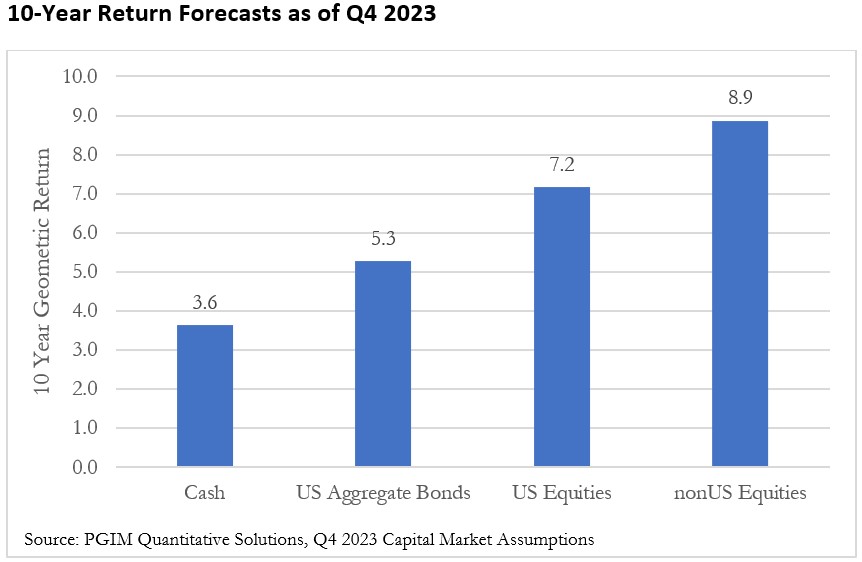To Make the Case for Equities in the Long Term, Look to the Past
While cash yields are attractive now, if we look at the performance of equities in the past, we can expect that, going forward, they could be a better bet.


Well, the year 2023 is officially a wrap. Overall market performance was relatively strong, with equities, defined as the total return of the S&P 500, up 26.29% for the year, and bonds, defined as Bloomberg U.S. Aggregate Bond Index, up 5.53%.
The strong performance of equities in 2023 was somewhat unexpected, with many market forecasters predicting lower returns at the beginning of the year, especially with growing concerns of a recession. The stock market return for 2024 is equally uncertain, and many investors may be looking to cash, given attractive yields exceeding 5%; however, it’s important to remember that equities have dramatically outperformed cash historically, especially over longer investment periods, and are expected to do so into the future.
Therefore, the case for equities is as strong today as ever, but it’s important to ensure the risk level of your portfolio is appropriate and to stay invested for the long term!
From just $107.88 $24.99 for Kiplinger Personal Finance
Be a smarter, better informed investor.

Sign up for Kiplinger’s Free Newsletters
Profit and prosper with the best of expert advice on investing, taxes, retirement, personal finance and more - straight to your e-mail.
Profit and prosper with the best of expert advice - straight to your e-mail.
A look back in time
There has always been risk associated with investing in equities, especially over shorter periods, which is why it’s important to take a long-term perspective when it comes to investing. If we look at total returns for U.S. equities from 1926 to 2023, which include the performance benefit of dividends, they’ve been positive for 73.5% of calendar years with an average annual long-term geometric return of 10.35%, as demonstrated in the chart below.

It’s important to note, though, while the total return on stocks has been positive for 73.5% of calendar years, if we look at five-year periods, it’s been positive 87.2% of the time, and if we look at 10-year periods, it’s been positive 95.5% of the time. In other words, being invested for the long term has definitely benefited investors.
The current high returns on cash, which exceeded 5% at the beginning of the year, may have many investors rethinking their longer-term strategy allocations and possibly underweighting equities in their portfolios. While it’s true that current cash yields are significantly higher than long-term averages, equities have dramatically outperformed cash over the long term. Looking at returns from 1926 to 2023, equities have outperformed by 6.9% per year on average and had a higher return 67.4% of the time, as demonstrated in the chart below.

Clearly, there have been times when cash has outperformed equities, in particular those years when the return on equities was low or negative, but over the long term, equities have dramatically outperformed cash. For example, stocks outperformed cash 76.6% of the time over rolling five-year periods and 85.4% of the time over rolling 10-year periods. Therefore, it’s important to take a long-term perspective when it comes to investing.
While it obviously is difficult to predict where the market is headed, one of our affiliates, PGIM Quantitative Solutions, does create forward-looking return estimates for the next 10 years. These forecasts can be used to help create expectations for investors around likely future returns. The latest return expectations available, as of Q4 2023, are included below, for a few common asset classes.

Some important things to be aware of with respect to these forecasts. First, there is still the general expectation that stocks will outperform cash and bonds into the future, but at lower levels than have been experienced in the past. Second, the forecasted return for U.S. equities over the next 10 years, at 7.2%, is notably lower than the historical long-term average, at 10.2%. This is more than 3 percentage points lower and important for investors to be aware of when running any kind of financial plan, given the pronounced potential effect.
For example, $1 invested at 7.2% for 10 years would grow to roughly $2 at the end of the period vs $2.66 if invested at 10.2%, which is roughly one-fourth lower.
Going forward
The common expression that past performance is no guarantee of future results is true today more than ever. Since it is impossible to know what’s going to happen in the financial markets, one of the most important things to try to control is investor behavior, by ensuring your portfolio is consistent with your objectives and staying invested for the long term.
Related Content
- Expecting a 12% Return on Your Portfolio? That’s Dangerous
- Your Retirement Readiness Rx: Plan Early and Get Help
- Four Historical Patterns in the Markets for Investors to Know
- Five Common Retirement Mistakes and How to Avoid Them
- What’s the Difference Between Average and Actual Rate of Return?
Profit and prosper with the best of Kiplinger's advice on investing, taxes, retirement, personal finance and much more. Delivered daily. Enter your email in the box and click Sign Me Up.

David Blanchett, PhD, CFA, CFP®, is Managing Director and Head of Retirement Research for PGIM DC Solutions. PGIM is the global investment management business of Prudential Financial, Inc. In this role he develops research and innovative solutions to help improve retirement outcomes for investors with a focus on defined contribution plans. Prior to joining PGIM he was the Head of Retirement Research for Morningstar Investment Management. He is currently an Adjunct Professor of Wealth Management at The American College of Financial Services and Research Fellow for the Alliance for Lifetime Income. David has published over 100 papers in a variety of industry and academic journals that have received awards from the CFP Board, the Financial Analysts Journal, the Journal of Financial Planning, and the International Centre for Pension Management. In 2014 InvestmentNews included him in their inaugural 40 under 40 list as a “visionary” for the financial planning industry, and in 2021 ThinkAdvisor included him in the IA25+. When David isn’t working, he’s probably out for a jog, playing with his four kids, or rooting for the Kentucky Wildcats.
-
 The Five Best Cruise Lines for Retirees
The Five Best Cruise Lines for RetireesRetirement is an ideal time for cruising. Check out the five best cruise lines for comfort, ease, and unforgettable experiences.
-
 My First $1 Million: Oil and Gas Retiree, 67, Round Rock, Texas
My First $1 Million: Oil and Gas Retiree, 67, Round Rock, TexasEver wonder how someone who's made a million dollars or more did it? Kiplinger's My First $1 Million series uncovers the answers.
-
 I'm a Retirement Coach: Eight Surprising Signs You're Ready to Retire
I'm a Retirement Coach: Eight Surprising Signs You're Ready to RetireYou've met your savings goal, your friends are having fun without you, your boss is mean to you, and your kids are grown and gone. What are you waiting for?
-
 'Work Forever' Is Not a Retirement Plan: What Needs to Change for Gen Z, From a Financial Pro
'Work Forever' Is Not a Retirement Plan: What Needs to Change for Gen Z, From a Financial ProSaving for retirement isn't what it used to be. The deck is stacked against Gen Z in some crucial ways. The system is broken, and we need to fix it.
-
 I'm a Financial Planner: These Three Things Are Missing From Almost Every Financial 'Plan' I See
I'm a Financial Planner: These Three Things Are Missing From Almost Every Financial 'Plan' I SeeA financial plan should be a detailed road map to a worry-free retirement. Watch out: If your plan has these common holes, you could be headed for a dead end.
-
 Is the One Big Beautiful Bill Really All That Great for Your Retirement?
Is the One Big Beautiful Bill Really All That Great for Your Retirement?While tax cuts sound attractive, it's still wise to plan ahead for retirement by considering strategies like Roth conversions to offset potential tax increases in the future and stealth taxes that could surprise you.
-
 Wages Aren't Keeping Up With Inflation: A Financial Adviser's Tips to Bridge the Gap
Wages Aren't Keeping Up With Inflation: A Financial Adviser's Tips to Bridge the GapWhile we can't control inflation, there are some simple things each of us can do to help keep our heads above water.
-
 New Rules, New Opportunities for Student Loans: An Expert Guide to Preparing for What's Next
New Rules, New Opportunities for Student Loans: An Expert Guide to Preparing for What's NextMajor changes are coming to federal student loan rules, so it's a good time for borrowers to understand how these shifts will impact their financial planning.
-
 Gray Divorce Can Throw Your Retirement a Curveball: What to Know
Gray Divorce Can Throw Your Retirement a Curveball: What to KnowIf you're entering retirement and going through a divorce at the same time, you've got some work to do to shore up your long-term financial security.
-
 I'm a Real Estate Investing Expert: Optional 721 UPREIT DSTs Can Be the Best of Both Worlds
I'm a Real Estate Investing Expert: Optional 721 UPREIT DSTs Can Be the Best of Both WorldsBefore investing in any 721 UPREIT exchange, look for one that offers a straightforward, investor-friendly exit.